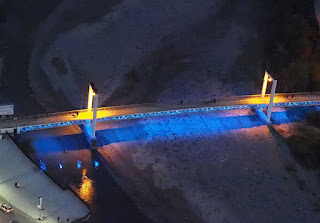After waking up and finding we couldn't get any hot water to our shower, our day went uphill from there. We headed out to the coastal city of
Durrës. Today Durrës is the main port of Albania. It is a container port and gets ferries in from all over the Adriatic and Mediterranean. It has all the hall marks of Mediterranean coastal city.
We went out on the pier for a coffee and caught the view of the shore line
Our guide Migen
A palace of the King in the early 19th century, King Zog...NOT beloved.
Nice place for wedding pictures
But we were not there for current culture. We were there for history.
For Durrës is the Dyrrachium of Roman fame. The western most terminus of the famous Via Egnatia linking Rome to Byzantium. All the greats from Sulla, to Pompey, to Caesar, to Mark Anthony, to Trajan, and Constantine set foot here. This city was important for centuries and centuries. After the Romans and Byzantines, all the powers of the Mediterranean, the Venetians, the Normans, the Angevins all sought it as well. It was only after the Ottoman conquest that it lost its importance. As such there is a wealth of archeological finds to be seen there. But because the city has been continuously inhabited, there has never been a complete archeological exploration. Most of the finds have come as the result of someone building something and stumbling into things. We went to its Archeological Museum which covers from the Illyrian period to the end of the Roman Empire (the collection of Byzantine and Medieval items awaits improvements to other floors of the building.
Then there is the ruins of the Amphitheater
The largest in the Balkans, it seated 15,000, about a third of the Colosseum in Rome. It was destroyed in a massive earthquake in the fourth century AD and then rebuilt.
Megin takes Wife through the ancient corridors
"Love, I once read about this Roman Emperor who fed his accountants to the lions because they were too diligent about pointing out his spending."
A fuller view
Rebuilt section
Original work
During the late Roman period, parts were converted to a church
View of the old city wall from the Amphitheater
Some street scenes right around the Amphitheater
Next we stopped in our guide's home town of Lushnja because he needed to get somethings.
We had our first taste of Byrek, basically phyllo dough filled with things like meat, cheese, or vegetables.
Here we had meat, spinach, and cheese
Then we went to a residential area where Migen went to pick up some things.
We were in a parking area between a number of six/seven story apartment complexes.
As we were just waiting, Wife and I got out of the car with our cameras. This was NOT a tourist place. We could see people staring at us from windows of the apartments. There is this moment of discomfort. Are you invading others privacy? Are you someplace you shouldn't be?
Then comes the ice breaker, usually some young people
And the attempts to communicate begin
Then someone older like this grandmother comes by. Oh how I wish I had Albanian. She was annoyed with the boys but in a sweet way. I think because they left trash around the parking area.
Now we are in full communication mode
I think one of the things I have noticed most in Albania is the genuineness of the smiles
Migen came back and he took us to see one of his two other jobs in addition to being a guide...being a radio host.
Radio Lushnja is the largest regional radio station in the country
"Love I bet they'd love to have a couple of travel bloggers put a show on their station."
"Hmmm you really think so?"
"I suppose it could be our big break"
Some views of Lushnja from the radio station office
The color of buildings here really strikes me
It was getting late and we still had to get to the old hill fortress at Berat where we are spending the night (in the town below actually)
(And no comments about yet another Medieval hill town...this is an Albanian one)
It was massive
It covers the confluence of major valleys of communication hence its strategic importance
There are about 50 families that live up in the citadel
Here is a typical window style
The famous Emperor Constantine that took the Empire to Christianity was an Illyrian of background. There is no proof that he was from Berat but they like to take credit anyway.
The sun was setting and there were great views of the modern city of Berat below
Before we went down to our hotel, Migen asked if we wanted to try Raki, the local spirit. Sure why not. He got some from a woman (a very cool woman who was making intricate sewn goods with a peddle driven sewing machine - you will have to go to Wife's blog for those pictures and her take on our conversation with the woman).
According to Migen you can tell the quality of the Raki by whether it will burn on your finger tip.
This was evidently good

















































2 comments:
Your adventures never cease to amaze me!! Love the way you present the history of the area followed with wonderful pictures! Your fun pictures in the Radio Lushnja studio are priceless!!
At least raki was good
Post a Comment